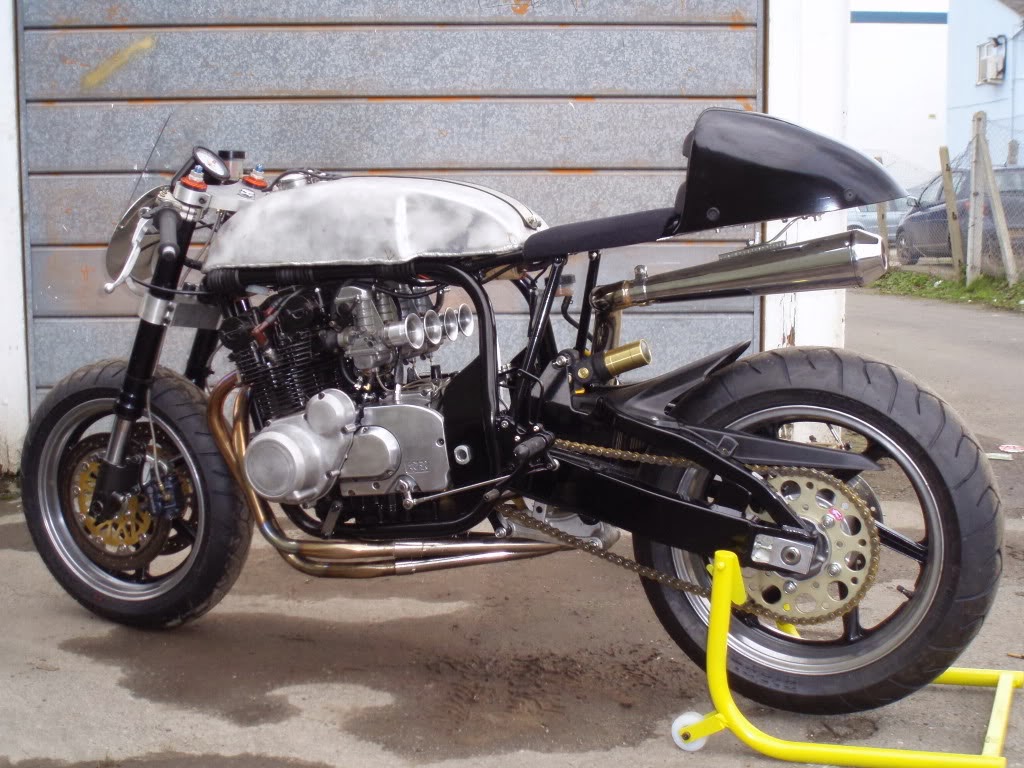Featherbed Racer | Featherbed frame | Featherbed Cafe Racer | Featherbed frame Design | Cafe Racer | Custom Cafe Racer Frame | Cafe Racer Featherbed Frame...[Join us on Facebook, Youtube, Twitter and Pinterest]
The featherbed frame was a motorcycle frame developed by the British Norton motorcycle company to improve the performance of their racing motorcycles around the twisting and demanding Isle of Man TT course in 1950. It was considered revolutionary at the time, and the best handling frame that a racer could have. Later adopted for Norton production motorcycles, it was also widely used by motorcyclists on custom built hybrids such as the Triton, becoming legendary and remaining influential to this day. The Featherbed was replaced with the Norton Isolastic frame for the Norton Commando in September 1967 but continues to be produced by specialist companies.
Origins
In 1949 brothers Rex and Cromie McCandless offered Norton a new frame to support their successful 500cc race single. Rex McCandless was a self-taught Belfast motorcycle engineer and raced competitively with his brother on a Triumph Tiger 100. He had made several improvements to the Triumph, notably an innovative new frame with a swinging arm fitted with vertical hydraulic shock absorbers from a Citroen car. BSA bought several of his converted motorcycles but Norton saw the real opportunity and contracted him to work exclusively for them from 1949. The Norton Motorcycle Company were concerned at the reliability of their plunger (or "Garden Gate") frame, as several had broken through the stress of racing. Norton engineer Joe Craig solved the problems by making the frames heavier but handling suffered as a consequence.
Norton commissioned the McCandless brothers to design a complete frame, incorporating a swinging arm. McCandless' finished design was expensive, as it required over forty feet of best Reynolds steel and was a welded twin loop with a swinging arm fitted with his own design of shock absorbers, with a heavily braced cross-over headstock. In two months a prototype motorcycle with the new frame was on the test track and it was tested on the Isle of Man in the winter of 1949. It performed well and Norton decided that the Norton works team would have motorcycles with the new frames. The Norton works was not well equipped so the sif-bronze welding was undertaken by McCandless who produced the eight frames for the racing team by hand
Single and Twin cylinders in Featherbeds
Having earlier installed the Dominator twin-cylinder engine of 500 cc and 600 cc, in 1959 Norton put the old single cylinder Model 50 (350 cc) and the ES2 (500 cc) into the Featherbed frame to rationalise production. Using grade A mild steel, the size of this engine determined the space between the top and bottom rails of the full duplex cradle. In 1960 the top rails were installed at the rear of the tank. Riders complained that these wideline Featherbed frames were uncomfortably wide at 11.5 inches (29 cm) but it was not until 1960 that the top runs of the frame were narrowed towards the front of the seat, with corresponding overall styling changes including tank and seat to create the slimline frame used until the last of the production twin cylinder machines were sold around 1968.
Origins
In 1949 brothers Rex and Cromie McCandless offered Norton a new frame to support their successful 500cc race single. Rex McCandless was a self-taught Belfast motorcycle engineer and raced competitively with his brother on a Triumph Tiger 100. He had made several improvements to the Triumph, notably an innovative new frame with a swinging arm fitted with vertical hydraulic shock absorbers from a Citroen car. BSA bought several of his converted motorcycles but Norton saw the real opportunity and contracted him to work exclusively for them from 1949. The Norton Motorcycle Company were concerned at the reliability of their plunger (or "Garden Gate") frame, as several had broken through the stress of racing. Norton engineer Joe Craig solved the problems by making the frames heavier but handling suffered as a consequence.
Norton commissioned the McCandless brothers to design a complete frame, incorporating a swinging arm. McCandless' finished design was expensive, as it required over forty feet of best Reynolds steel and was a welded twin loop with a swinging arm fitted with his own design of shock absorbers, with a heavily braced cross-over headstock. In two months a prototype motorcycle with the new frame was on the test track and it was tested on the Isle of Man in the winter of 1949. It performed well and Norton decided that the Norton works team would have motorcycles with the new frames. The Norton works was not well equipped so the sif-bronze welding was undertaken by McCandless who produced the eight frames for the racing team by hand
Single and Twin cylinders in Featherbeds
Having earlier installed the Dominator twin-cylinder engine of 500 cc and 600 cc, in 1959 Norton put the old single cylinder Model 50 (350 cc) and the ES2 (500 cc) into the Featherbed frame to rationalise production. Using grade A mild steel, the size of this engine determined the space between the top and bottom rails of the full duplex cradle. In 1960 the top rails were installed at the rear of the tank. Riders complained that these wideline Featherbed frames were uncomfortably wide at 11.5 inches (29 cm) but it was not until 1960 that the top runs of the frame were narrowed towards the front of the seat, with corresponding overall styling changes including tank and seat to create the slimline frame used until the last of the production twin cylinder machines were sold around 1968.













